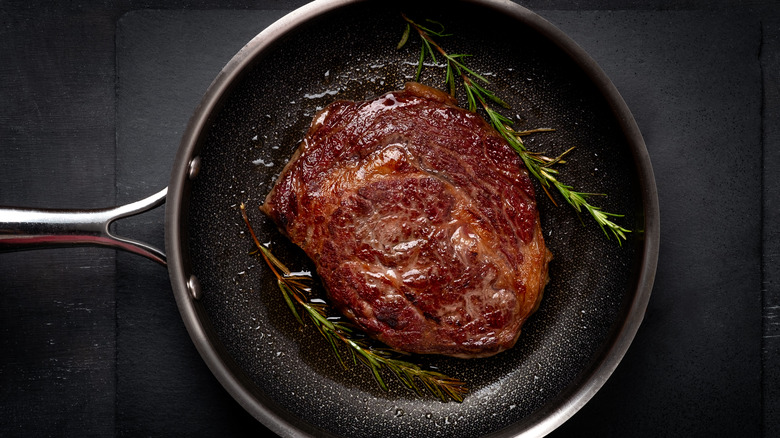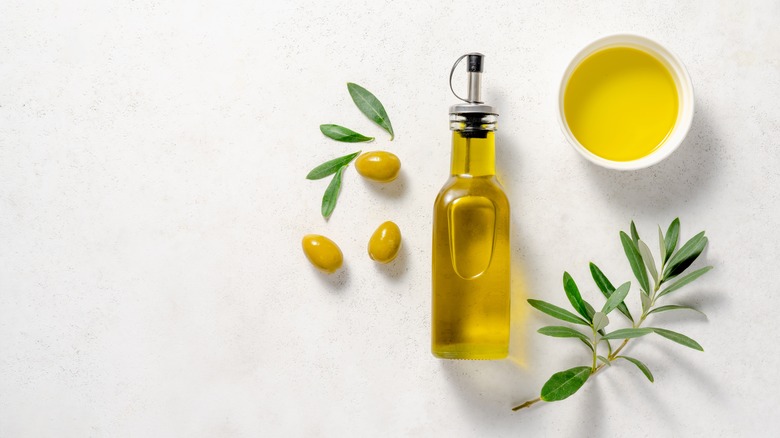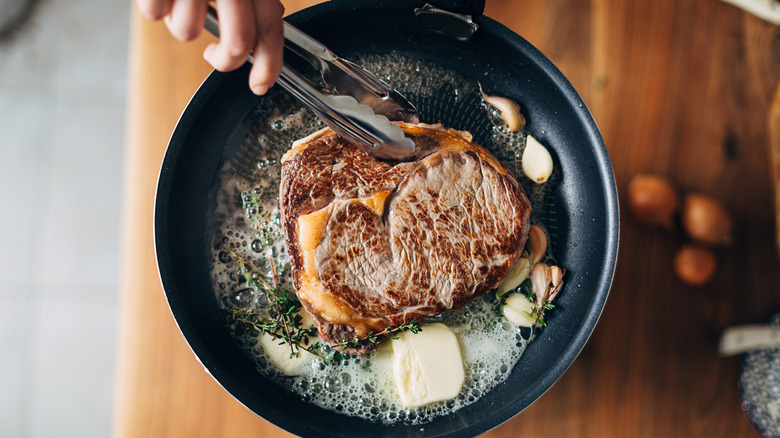Butter Vs Olive Oil: Which Is Better For Steak?
Any professional chef or experienced home cook will tell you that one of the top tips for cooking a great steak is perfecting the sear. For a perfect, mouthwatering crust packed with flavor, you need a screaming-hot pan and enough cooking fat to encourage sizzling. Skipping out on the latter is a mistake that could ruin your pan-seared steak. Oils like olive oil are a popular choice, but some recipes call for butter to add a richer flavor.
While it's tempting to sear your steak in creamy, delicious butter, you should actually opt for olive oil. Butter could result in a steak that's either burnt or lacking a good crust, because it has a low smoke point, i.e. the temperature at which it starts burning. Therefore, if you crank up the heat on a pan filled with butter, it will burn, and if you keep the heat low so that it doesn't smoke, you won't achieve that perfect sear.
The smoke point of butter is around 350 degrees, and it has the added disadvantage of milk solids and proteins that burn more easily than pure oil, ruining the texture and flavor of your steak. Light or refined olive oil, meanwhile, has a smoke point of around 465 degrees, so it can stand up to those high temperatures needed to brown the beef. That's not to say that you can't add some butter to the pan to boost the flavor — you just need to do it at the right time.
Tips for searing with olive oil
Pan-searing your steak in olive oil will give you a delicious brown crust that occurs due to the Maillard reaction — a chemical reaction that changes meat's color as it's cooked, develops a crisp crust, and adds a rich, savory flavor. The only pitfall is that extra virgin olive oil can be tricky to use. While this type has a lower smoke point than refined or light oils, recent research reveals that EVOO may be more stable at high temperatures than previously believed.
That being said, it's still generally advised to use light or refined olive oils, since they have reliably higher smoke points. These oils also have a neutral taste, as opposed to EVOO's grassy flavors, so they won't affect the flavor of the meat. Other neutral oils with high smoke points include canola, vegetable, and peanut oil. Grapeseed and avocado oil have slightly lower smoke points, but will also work for pan-searing.
When searing your steak, you can either heat the pan before adding the oil, or add the oil first and then heat it. Just make sure it's is hot when the steak goes in — if you lift the pan and swirl the oil around, it should look thin and watery with a slight shimmer, not thick and slow to spread. Another method employed by some chefs is to rub oil into the steak instead of adding it to the pan, which somewhat protects the oil from breaking down.
Butter baste to boost the flavor
You might not want to cook your steak in butter only, but you can butter-baste it to add a delicious richness. Because the butter won't be in the hot pan from start to finish, you shouldn't have any issues with burning. After you've pan-seared your steak for a few minutes per side, flipping often to ensure an even sear, you can start the basting process. Add a couple pats of butter and some herbs and aromatics like thyme, sage, and garlic directly to the pan.
Now's the time to start channeling your inner chef. Tilt the pan so the melted butter and juices collect on one side, then spoon the liquid evenly over the steak. If you've watched one of his many TV shows, you've likely seen Gordon Ramsay's tilted pan technique for better seared steak, and the same idea applies here. Don't forget to continue to flip the steak frequently to get the most even cook.
Ideally, you would continue to baste and flip the steak until it reaches your desired doneness. However, not everyone has the time to stand over the stove constantly — if that's the case, try to flip the meat at least once or twice until it's finished. Searing your steak in olive oil and basting it in butter will result in a perfect dish that you'll be proud to serve to your friends and family.


